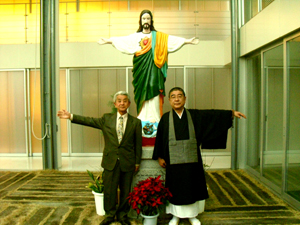People should secure their furniture.
Kobe City, Hyogo-ku, Sairin-ji Temple, Head Priest: Kazunari Akashi
Talk 1
Sairin-ji temple was built after World War 2. At the time to of the earthquake I was living in the temple with my wife and child. Early in the morning of the earthquake I was woken up by the sound of mice running around in the attic, so I got a broom and banged it against the ceiling to chase them away. Just then, I heard a loud sound and felt it was an earthquake. Just after I got my child and put him under the bed for shelter, a wardrobe fell over on it. I suppose you could say we were warned by the mice. They probably had a premonition that the earthquake was going to happen.
I met a director of a local kindergarten and told him about my experience. He said that human beings probably had the same ability long, long ago, but lost it when they became involved in trade and industry. He said the first to have this premonition was birds, they felt it in the air. He could hear the birds around the kindergarten just before the earthquake.The roof of the main hall of the temple was cracked open, the double glazing in the windows was smashed. Fifteen years after the earthquake, the main hall of the temple is still in a temporary building. In circumstances like this, I couldn’t ask temple members for donations for its reconstruction. Although I have been involved in many donation collection campaigns, none of it was for my temple.
Many of my temple members had to move to temporary housing, so I had a Buddhist altar maker make temporary family altars for these people. Funds for this came from a donation campaign by the all Japan Buddhist youth association. Sairin-ji is a Pure Land Sect Buddhist temple, but the Buddhist youth association is not confined to any one sect, in fact, it is open to ordinary people too, including Buddhist altar makers, caterers, etc.
The neighborhood was badly hit by the earthquake. A wooden apartment building collapsed and its residents escaped from the second floor in their pajamas. There happened to be a vacant lot beside the temple, and we cut the wire fence and I brought out steel a drum we had in the temple and used it as a fireplace. The first day, we cooked hot food on the fire. Ingredients came from the local ‘okonimiya’ restaurant’s refrigerator and kitchen. That lasted for about a week. We then went to Hyogo Junior High school and asked the principal if he could arrange for 5 lunches daily for the neighbors.
Talk 2
About the earthquake I became one of 5 people who founded a movement to have earthquake memorial ceremonies organized by ordinary people. I was invited to join this movement by a Christian pastor who was active in volunteer work. I got a phone call from a fellow Buddhist priest in Osaka asking me if I would meet someone in Kobe who wanted someone from the Buddhist community to join the Bosai Fukushi Forum. That is how we got to know each other. We invited a member of the Shinto religion to join us and held a memorial ceremony with 7,000 candles (there were about 6,400 earthquake victims at the time). We asked for 500 donations to pay for the candles, candles stands, etc. The Buddhist association built the candle stands for the event.We later formed group called Shinsai wo Ikiru Shushokusha no Tsudoi (a group of priests from different religions working to help people live through the earthquake) otherwise known as ‘Warugaki no Kai (the bad boys group). The group included the parish priest of Takatori Catholic Church, a Spanish priest named Michelangelo, the head priest of the Shinto Tosen Shrine in Arima, and Yuzurha Shrine in Higashinada, and a priest from the Rinzai Sect of Buddhism. Originally, we had casual get-togethers, but we then started study sessions. We religious priests needed to think about what our role was in helping people live through the disaster. Though meeting priests from other religions and sects, we were able to see the differences and similarities, and were able to reflect on our own religion. If you don’t know yourself, you are hardly likely to know others. There are areas where we can cooperate, and that is a big merit.Most religions, Christian, Shinto, Buddhist, Islam, Jewish, etc basically want to bring happiness to people. Religions are made up of people and unfortunately people naturally have desires and greed and unfortunately religious groups sometimes end up fighting each other. This is not the religion, but the human members and their greed; unfortunately, this gets the name of religious wars.
Some temples I know opened their doors to become shelters for earthquake victims, and some closed theirs. This depended on the head priest of the temple. I think they should have all opened, but as I said, they are run by human beings and what happens depends on that human being and their character. Basically, Buddhist temples are run on a ‘danka’ (members) system, and are generally not open to the general public, and this is something we have to think about.If I am asked to give a message to younger people about what to do in an earthquake, I would tell them that most people who were killed in the earthquake, even those killed in fires, were trapped under furniture, so people should secure their furniture. People should also take out earthquake insurance. Also, people shouldn’t be shy about admitting they don’t know something, they should ask and find out about things they don’t know, so those who have experienced something should tell those who haven’t what it is like.

